Must Reads: These boxes are a billion-dollar industry of homesickness for Filipinos overseas
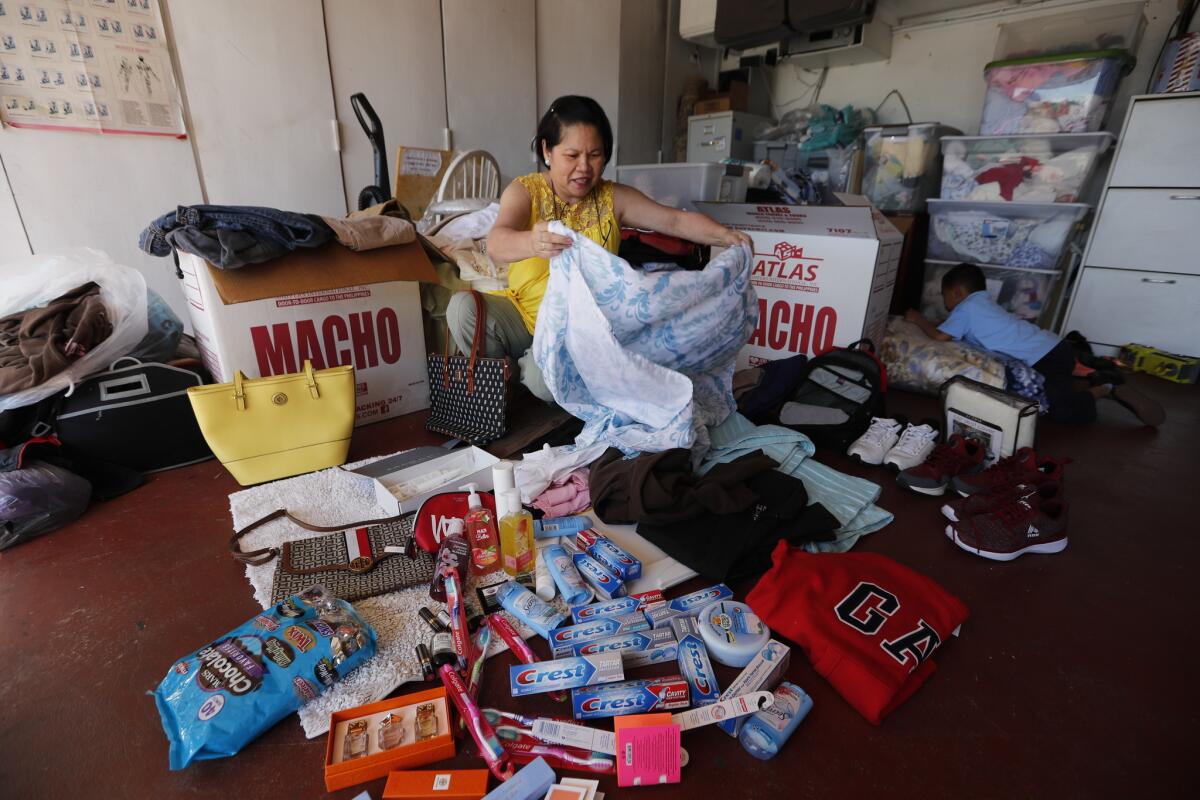
- Share via
About three hours before Philippine Airlines Flight 102 leaves for Manila from LAX, the boxes begin to spill onto the curb outside Tom Bradley International Terminal.
Packed with gifts such as Kirkland chocolates, hand-me-down clothes and Spam for relatives overseas, the cardboard containers crisscross the terminal in a daily game of luggage Tetris, driven by the Filipino tradition of packing, sending and traveling with balikbayan boxes.
The practice originates with a Philippines government-sponsored program that offered special tourism incentives, including baggage allowances, to encourage overseas workers to return and spend their wages in the homeland.
Today balikbayan boxes, named after the Tagalog word for a returning Filipino, have become one of the most enduring symbols of the Filipino diaspora. The boxes help feed relatives who are struggling, console daughters separated from their mothers, and give far-flung overseas workers a tangible tether to their families.
This is the Filipino way. You can't go home without a box.
— Marie Maruquin
“There are many who spend their entire lives as caregivers, and the boxes are sometimes their only remnant of a home in the Filipino community,” said Anthony Ocampo, a professor of sociology at Cal Poly Pomona and the author of “The Latinos of Asia: How Filipino Americans Break the Rules of Race.”
On a recent weekday, Marie and Ruben Maruquin, accompanied their aunt, Erlinda Rosas, of Glendora, to Los Angeles International Airport, where they pushed her balikbayan box up to the ticket counter. It weighed 58 pounds, 8 pounds above the limit.
Heaving a sigh, the Maruquins wrestled the box back onto the cart and pushed it over to a table in the area for above-weight luggage. Scissors, tape and bungee cables appeared from somewhere inside Rosas’ purse.
She tore open the box and removed a large sack of oranges, clothes, fabric shopping bags and a pair of sneakers. She stuffed the clothing into the bags, which she brought just in case the box turned out to be too heavy, and handed Marie the oranges, her discarded shoes and everything else to take back home. Then, with Rosas leaning a knee on top of the balikbayan while Ruben wielded tape, they laboriously reassembled the box.
By now everyone was somewhat winded. As a method of showing affection, balikbayan boxes are bit inconvenient, Marie conceded.
But they wouldn’t have it any other way.
“This is the Filipino way,” she said. “You can’t go home without a box.”
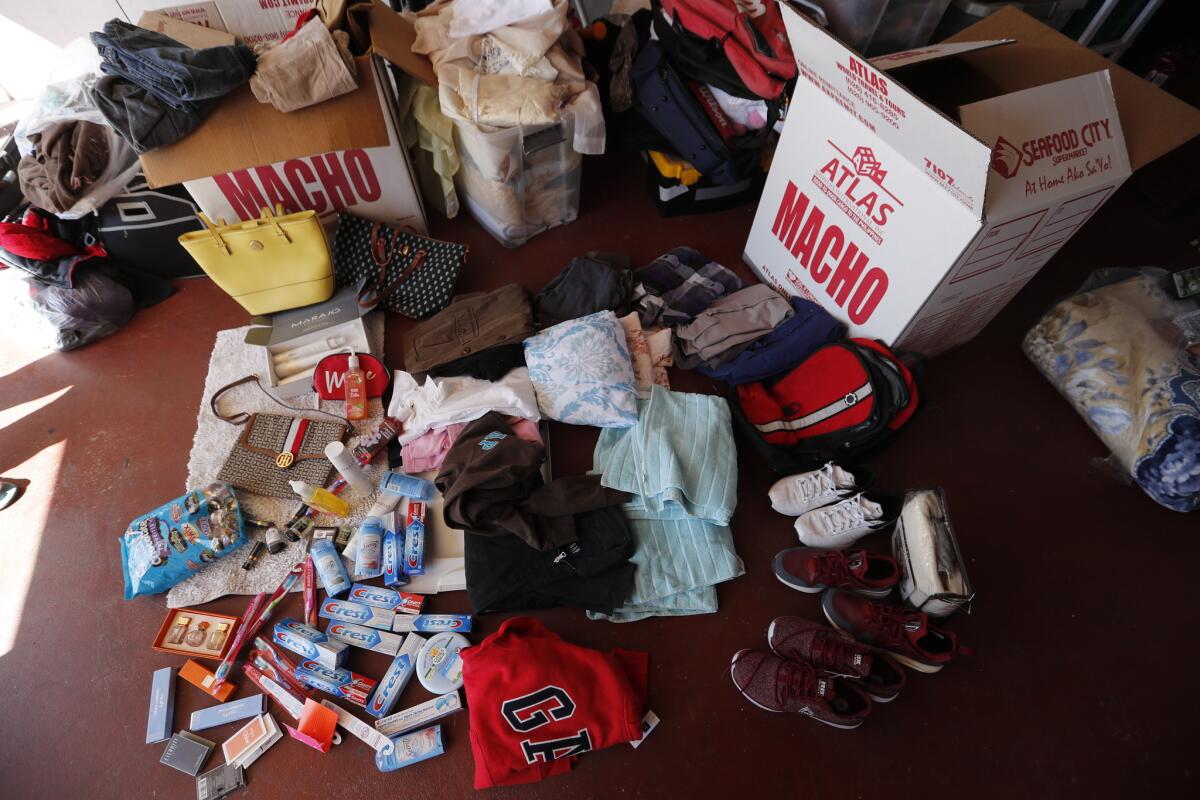
What's in a balikbayan box?
Amy Guzman, who will be visiting her family in the Philippines, displays the contents of the two balikbayan boxes she will take to her family. Here's what's inside:
Colgate, Crest and Secret deodorant: American brands like Colgate and Crest seem like mundane inclusions, but they are especially desirable in the Philippines, where a history of U.S. colonization has shaped consumer tastes.
Clothes: Many balikbayan boxes contain new or used clothing for relatives in the Philippines, often contributed by relatives in the U.S. And U.S. shoe brands like Nike and Adidas win fashion points with young people, because certain models released in the U.S. aren't available in the Philippines.
Purses, perfumes and makeup: Boxes also contain more traditional gifts from overseas Filipinos who want to share their relative wealth with their less fortunate family members back home. The peak of the balikbayan box season is always Christmas.
The boxes: Large door-to-door balikbayan box companies like Atlas, LBC, and Starkargo have professionalized the practice of sending balikbayan boxes via shipping container or airmail. Shipping a box costs anywhere from $40 to $80, and it's often cheaper to send boxes to the Philippines through these services than it is to send it across the street using U.S. carriers.
Backpack, towels and sheets: A balikbayan box is typically preceded by weeks of communication between overseas Filipinos and their relatives in the Philippines to try to learn about the needs and wants of each of their family members. Guzman has included a backpack, towels and a comforter according to her family's needs.
Chocolate: Chocolates, and many other kinds of sweets, are one of the most common balikbayan box items. Common brands like Snickers and M&M's are highly desirable, and more expensive candy brands like Ferrero Rocher are comparatively affordable in the U.S., and they can be purchased cheaply, in bulk, at American stores like Costco.
Carmelita De La Cruz, 70, has leg pain and travels through airports in a wheelchair. But that doesn’t stop her from lugging about 100 pounds’ worth of gifts every time she visits her relatives in the Philippines. She has sent nearly a dozen balikbayan boxes to the Philippines annually for the last 12 years she’s been in the U.S.
De La Cruz’s boxes pile up in the garage at the Thousand Oaks home of her daughter, Jennifer Virgines, and son-in-law, Ahmed. There are so many they crowd out the couple’s car. They scold her, but with smiles. Virgines remembers a time when the boxes her mother sent were the best proof of her love.
“The boxes show her feelings,” Virgines said. “They are in her blood.”
When Virgines was 9, De La Cruz, along with thousands of other Filipinos, relocated to another country to earn money for her family.
The 1970s brought high unemployment to the Philippines and a state-sponsored effort to export labor around the world. Thousands of Filipinos like De La Cruz accepted vast distances from their families as a requirement for survival.
For many overseas Filipinos, balikbayan boxes became the best way to to bridge that distance. De La Cruz, who worked as a domestic helper in Hong Kong, scrimped and saved to put dresses, chocolates and toys in her children’s care packages.
The practice was formalized by an official government initiative to encourage returning Filipinos, or balikbayans, to spend their foreign wages at home in the Philippines. Tourism officials offered reduced airfares on the then-government-owned Philippines Airlines, hotel discounts, tax breaks and, most important, generous baggage allowances.
Returning foreign workers, who earned far more than their relatives could back home, needed to bring so many gifts that they soon quit using luggage in favor of large cardboard boxes, which could be packed to the very limit of an airline’s weight allowance.
The balikbayan promotion was supposed to last only six months, but the profitable initiative was extended repeatedly until it became permanent. Now, about 10 million Filipinos work abroad. At least 400,000 balikbayan boxes are sent every month, according to the Door to Door Consolidated Assn. of the Philippines. That number drastically increases during the holiday season.
In 1987, the government officially waived taxes and duties on goods in balikbayan boxes. Around that time, in Los Angeles and other Filipino enclaves in the U.S., entrepreneurs like Rico Nunga, 60, began to offer door-to-door delivery of balikbayan boxes to the Philippines for between $40 to $80 — cheaper than it would cost to send a box across the street. Nunga, who founded one of the first door-to-door companies in 1985, said the box sizes were set large to maximize the space inside standard shipping containers.
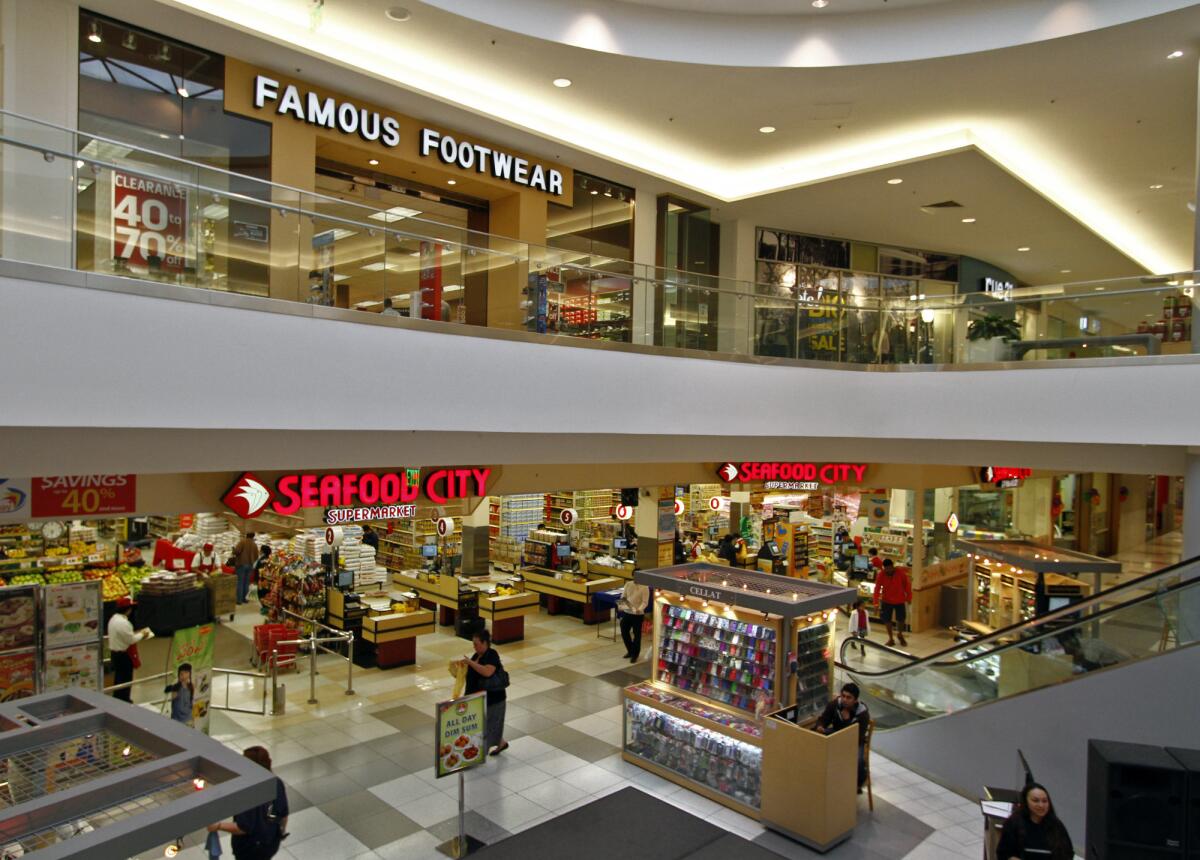
Other box companies quickly spread to Filipino enclaves around the nation, where they’re now a common sight in places such as West Covina, Eagle Rock and Carson, especially near locations of the Filipino supermarket Seafood City.
For most of Jennifer Virgines’ childhood, De La Cruz’s boxes proved that her mother was always thinking of her, Virgines said. And when De La Cruz retired after 40 years cleaning houses in Hong Kong, Virgines brought her to America so that they could finally be together.
She had hoped that they could enjoy a quiet, comfortable retirement together. But almost immediately, De La Cruz took a job as a cashier at a Ralphs grocery store.
Her mother was bored, Virgines said, and there was something else De La Cruz needed money for: sending balikbayan boxes to her family in the Philippines.
The contents of a balikbayan box are shaped by history, colonialism and Filipino ideas about family.
But much of it can actually be found at Costco.
American-made or American-sold products are highly coveted. Vending machine standbys such as M&M’s, Snickers, Twix and Reese’s convey status upon relatives in the Philippines because they’re American products, which are seen as higher-quality, special-occasion foods. Colgate toothpaste, Spam and corned meat are big.
Decades of U.S colonization and influence made many Filipinos avid consumers of American culture and products, Ocampo said. Generations grow up under a public education system established by an American government that uses English as the official language of instruction. And American products bound for Asian markets flowed through the Philippines and found customers in Filipinos, Ocampo said.
But boxes are more than just vessels for pasalubong, the Tagalog term for souvenirs for relatives.
Before a box is sent, the sender usually speaks with relatives and friends about their tastes, preferences and needs. Relatives who have never met one another can form close relationships through phone calls, video chats and gift giving.
Ocampo himself grew up with boxes all over his house. When his grandmother took him out shopping for shoes, she would carry handmade cut-out stencils of his cousins’ feet so she could send them correct size of shoe. His old clothes often went into boxes, then appeared on his cousins. When his grandmother passed away, his cousins took the loss hard, even though they had never spent much time with her.
“She was always calling them and sending stuff back to them,” Ocampo said.
If the sender’s family is poor or lives in a rural area, the box is more likely to contain rice and other staples. If the sender is prideful, the box may be full of expensive products even if the sender’s bank account is nearing empty. The boxes embody the little white lies immigrants tell to console their relatives back home and affirm their decision to leave.
“Home could be in complete disarray. They could be living a not great life,” Ocampo said. “But the box is going to be the box, and that’s all people are going to see.”
After a long shopping session at the Torrance Costco on a recent weekday, Norbyl Caburog parked a shopping cart piled high with canned goods, toilet paper and rice and unwraps a burger from the food stand.
Caburog and his wife send boxes to their relatives in the Philippines about five times a month, and he is part-owner of a box company himself.
When relatives complain of aching joints, they send vitamins. When babies are born, they send diapers. When relatives gamble away the money they send, Caburog and his wife send rice, Spam and other staples so they won’t go hungry. Some of the boxes cost almost a thousand dollars to put together, but Caburog won’t call the practice an obligation.
“It’s just that you can make them happy,” Caburog said. “We have to share our blessings.”
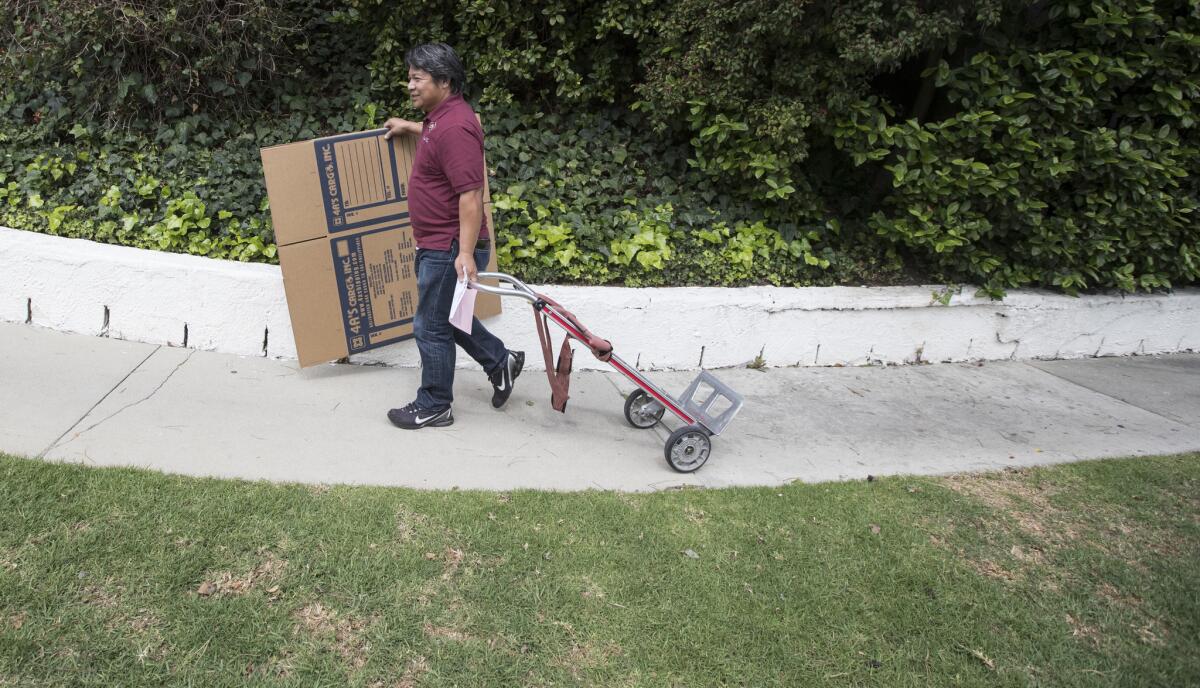
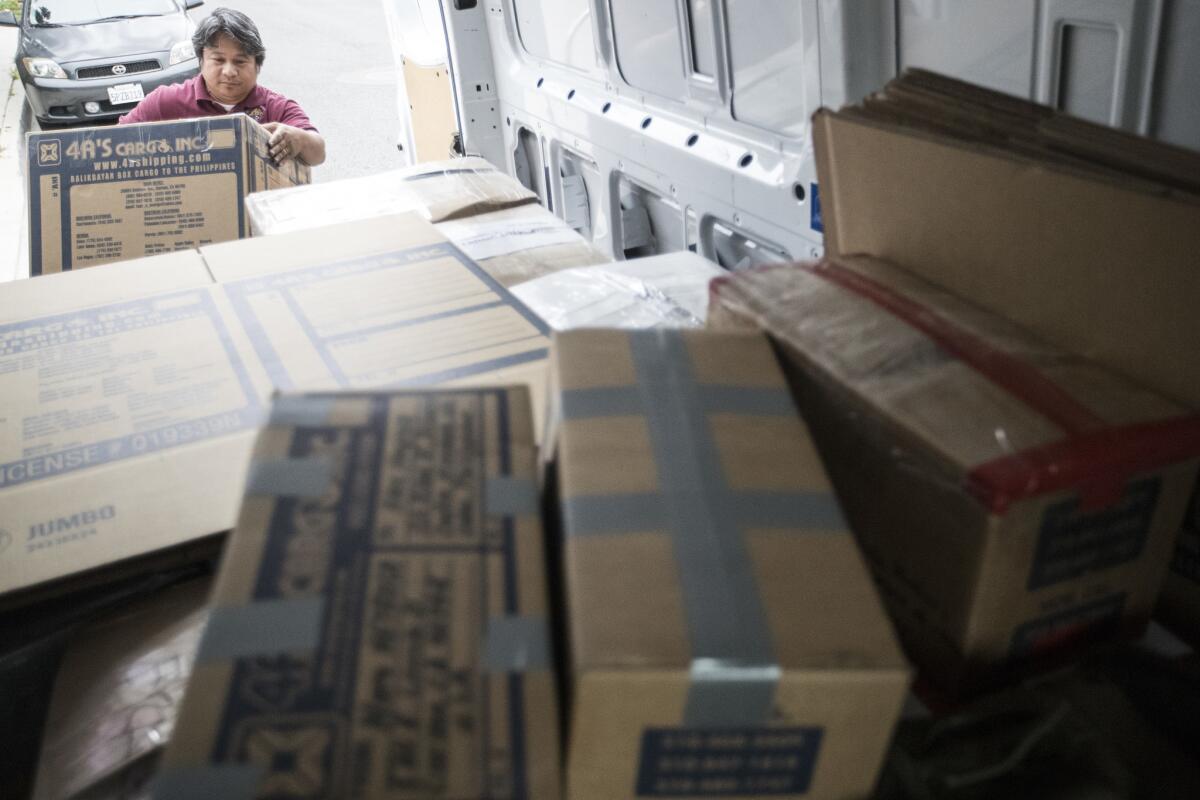
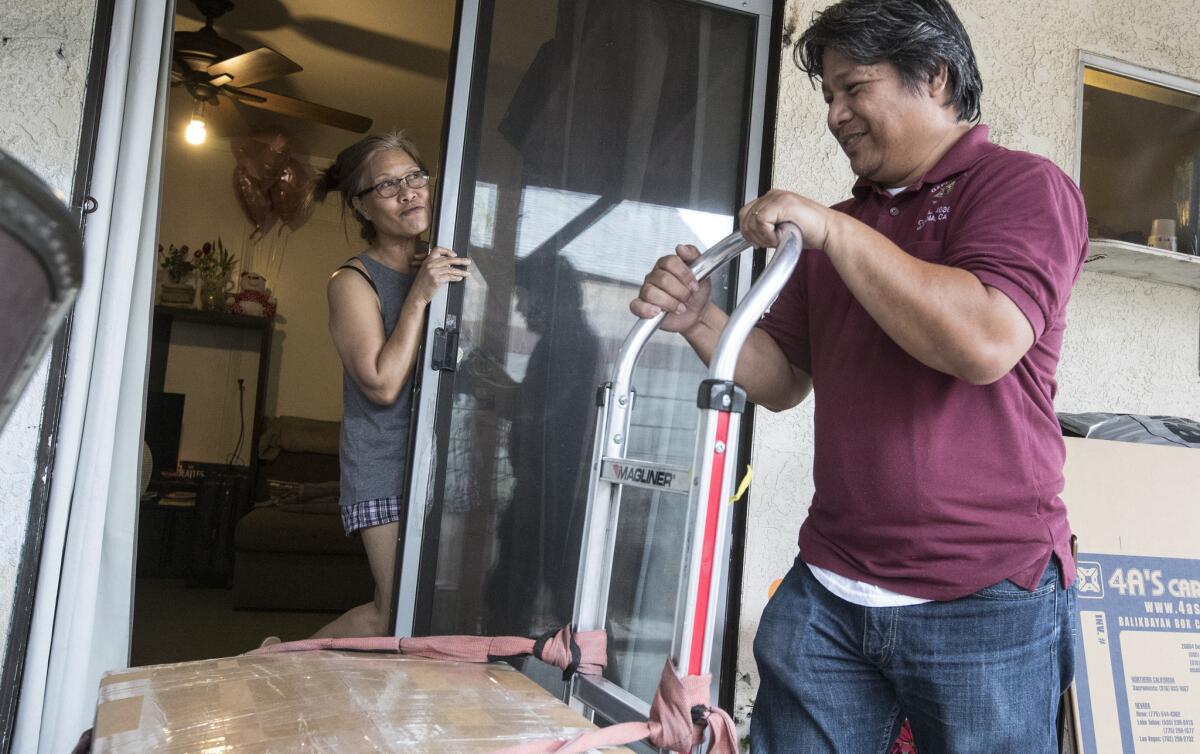
The practice of sending and traveling with balikbayan boxes is less popular with young people, said Rachel Cerdenio-Howell, a professor of English at East Los Angeles College who came to the U.S. with her family when she was 7.
Growing up, she even found the tradition a little annoying — as when she wanted to backpack through the Philippines as a graduate student and was instead saddled with two 70-pound boxes for her relatives on the way to the airport.
But then she saw her mother pack a camera into a box. That camera become her nephew’s hobby, then livelihood. Cerdenio-Howell saw how much sending the boxes meant to her mother, and how much receiving them meant to her relatives. She learned that her mother had worked her whole life so that her aunts and uncles could go to college. The boxes were her attempt to continue taking care of her brothers and sisters, Cerdenia realized.
“I started looking at my culture differently,” Cerdenia said.
Now, when she plans a trip to the Philippines, or if her kids outgrow their clothes, she knows that she must buy a box.
“It’s one of the things that’s a part of us. We hope to instill it in our children’s generation too.”
Twitter: @frankshyong
FOR THE RECORD: May 22, 10:50 a.m.: An earlier version of this article misstated the college where Rachel Cerdenio-Howell teaches. She is a professor of English at East Los Angeles College.
Sign up for Essential California
The most important California stories and recommendations in your inbox every morning.
You may occasionally receive promotional content from the Los Angeles Times.








